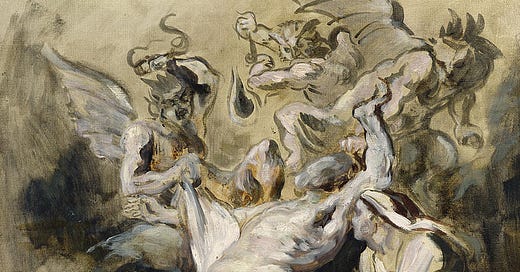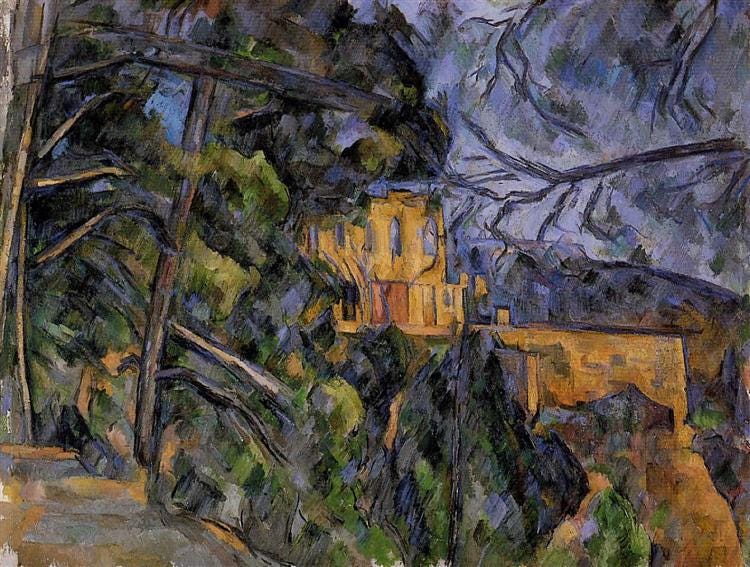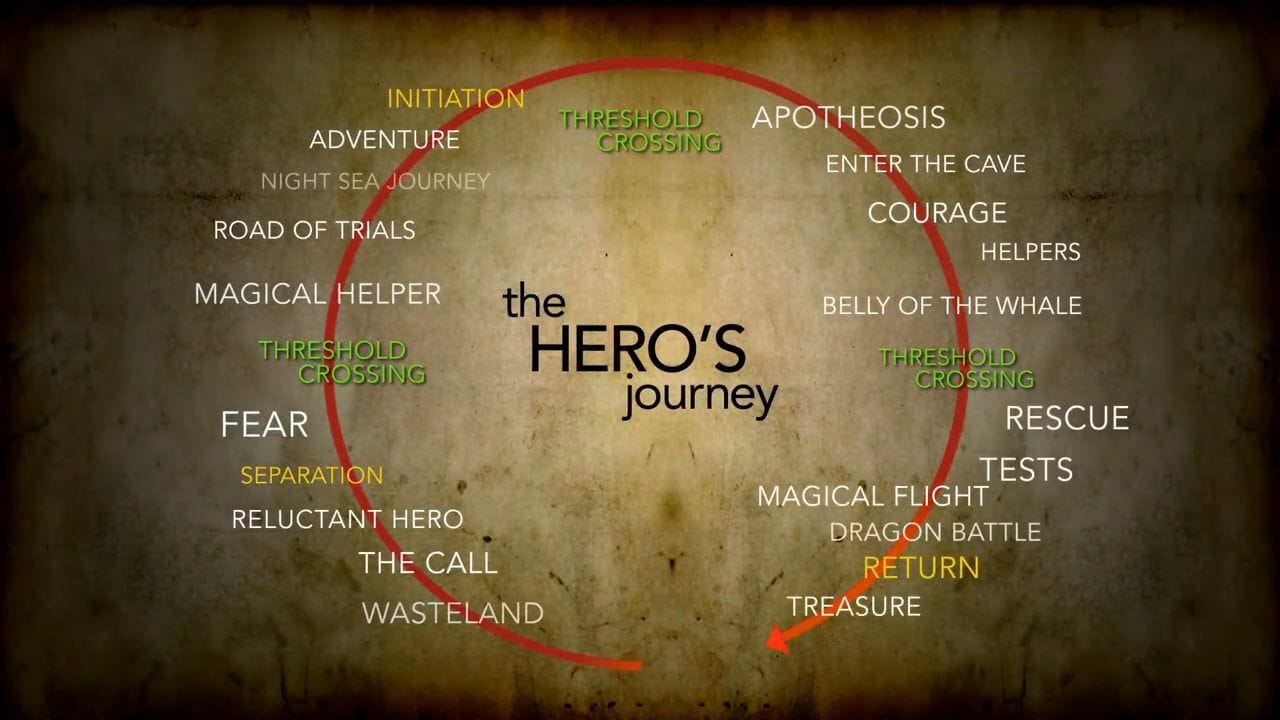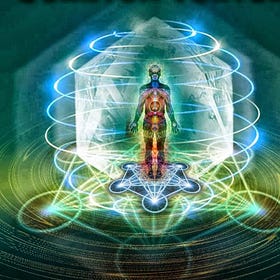Your mind is an orchestra of archetypal characters, with you as the conductor. When these archetypes are in harmony, both the physical and spiritual realms align, leading to mental clarity and balance.
However, when the ego takes over, the harmony is disrupted — Mozart transforms into Black Sabbath. The ego will always seek control, positioning itself as the director of your spiritual journey and attempting to dictate the flow of your archetypes.
Many people equate spirituality with religion, which leads to a neglect of the spiritual aspect of the psyche that deeply influences behavior. Religion, as with all dogmas, tends to focus on rigid beliefs. In this sense, religion becomes the entropy of spirituality — a process that drains spiritual vitality. If entropy is the gradual decline into disorder, then dogmatic religion is like a cold, stale cup of coffee.
What sorrow awaits you teachers of religious law and you Pharisees! Hypocrites! For you are like whitewashed tombs — beautiful on the outside but filled on the inside with dead people’s bones and all sorts of impurity. In the same way, on the outside you appear to people as righteous but on the inside you are full of hypocrisy and wickedness.
Matthew 23:27-28
The spiritual aspect of the psyche yearns to live, breathe, think critically, and engage with the spiritual realm with the same ease a conductor directs an orchestra. However, religion often chooses to ignore this orchestra, repeatedly revising old, worn-out doctrines. In the West, religion has become tone-deaf to the Music of the Spheres.
Here endeth the rant.
To better acquaint ourselves with archetypes, let’s briefly examine the archetypal influences on two great artists and their work. The first, Delacroix’s Job Tormented by the Demons, is pictured above. The archetype of the “suffering hero” is central here, representing human endurance and faith in the face of overwhelming adversity.1
God allowed Satan to test his loyal servant Job. (Theology: Oftentimes, Satan requires God’s special permission to act.)
Have you considered my servant Job? There is no one on earth like him; he is blameless and upright, a man who fears God and shuns evil.
Job 1:8
Job’s ensuing trials, a series of disasters that strip him of everything he holds dear, serve as his test of faith. This archetype appears in many religious stories where a higher power challenges the protagonist’s faith and resilience.
While Delacroix’s painting conveys a specific narrative with clear elements, Cézanne’s Chateau Noir (also known as Devil’s Castle) creates an evocative mood, leaving much to the viewer’s interpretation.
Depressing, isn’t it? Cézanne’s depiction of the castle nestled in a chaotic natural landscape reflects the archetype of nature’s duality — both orderly and chaotic; good and evil. This mirrors the human experience of seeking structure within chaos.— an island in the storm.
For Cézanne, the castle might also represent the dual archetype of isolation and introspection. The artist spent much of his later life in solitude, and the Château Noir could symbolize his own complex, blurred inner world. This sense of impending turmoil and introspection that many of us feel today can also be seen in the apocalyptic imagery of the Book of Revelation:
But woe to the earth and the sea, because the devil has gone down to you! He is filled with fury, because he knows that he has only a little time.
Rv 12:12
Self-awareness is crucial in understanding one’s beliefs and behaviors. Recognizing the spiritual role archetypes play in one’s faith allows us to become Job-like — ‘able to stand against the schemes of the devil.’
No one in the Bible suffered more than Job except Jesus. When we come across the term, “the faith of Job,” we should recall it in Job’s own words:
Naked came I out of my mother's womb, and naked shall I return. The Lord gave, and the Lord hath taken away; blessed be the name of the Lord.
Job 1:21
In the end, Job’s fortunes are restored, and he gains a deeper understanding of God’s nature. Job’s experience reveals that faith and trust in God can persist even in the face of inexplicable suffering. It also underscores the idea that human beings are part of a larger, mysterious divine plan, and that we humans cannot fully comprehend divine wisdom and the workings of the universe.
What are Archetypes?
The ego, according to Jung, is the aspect of the psyche that is consciously aware. It is your identity, your ‘I am.’ Archetypes, on the other hand, represent aspects of the psyche’s collective unconscious. They can influence, and in some cases dictate, individual behavior.
Jung emphasized that archetypes are inherited aspects of the collective unconscious passed down through generations, presumably as part of one’s DNA. Rational Spirituality recognizes this transmissibility, but emphasizes the conscious mind’s ability to communicate directly with the Akashic Field, the repository of all collective unconscious archetypes.
The Akashic Field is a cosmic energy and information field that retains all information related to a person, including information about ancestors, energy blockages, and soul predispositions. It is a universal “storehouse” of information about the past, present, and future potentials.2
In this piece, we aim to delve into the psychic mechanism of archetypal influence and possession and its physical transmissibility. Regarding the latter point, the movie The Fallen features Denzel Washington as a detective who discovers that a demonic entity named Azazel can transfer from person to person through touch.3
In Judaism, Azazel (literally ‘strong one against God’) was a force of evil. It was common for Jews to make sacrifices to Azazel at the same time that they made sacrifices to Yahweh. As described in the Bible, Azazel’s sacrifices were made by driving a goat, symbolic of sin, into the desert wilderness. These sacrifices were not intended to honor Azazel as a deity per se; rather, they symbolized the people sending their sins back to their original source.
In mythology, God cast Azazel down to earth with other angels. Azazel led a group of angels who mated with mortals. (Books of Enoch, ancient apocalyptic religious texts.)4
Then, he began teaching evil to humans. He taught men the art of warfare and of weapon-making, and he taught women “the art of deception,” which involved making and wearing cosmetics. Finally, he began teaching humans about witchcraft. His influence was so disastrous that, in the Book of Enoch, God says, “The whole earth has been corrupted through the works that were taught by Azazel: to him ascribe all sin.”
Returning to the film, “The Fallen,” passing evil through touch is a metaphor for passing it through contact. To cite a real-world example, in Operation Paperclip, the U.S. imported some 1,600 Nazi experts in various fields, most notably science and rocketry, around the end of WWII. In addition to scientists, some were occultists, expert in the Dark Arts.
These adopted Nazis helped create the CIA’s MKUltra and Project Monarch mind control programs. The intelligence agencies likely were unaware of the spiritual ramifications and satanic origins of these Nazi programs, which we wrote about here in The Great Holy War of 2024-25.
One way or another, through direct contact or incidental exposure to their nefarious agenda, this small Naziesque quartet, whose conductor is Azazel, produced the music of demonic sirens, the evil enchantresses of humanity. This unholy quartet, as we detailed here, includes Lucifer, Ahriman, and Sorath the Antichrist. All are satanic archetypes, the sour-note sirens of death and destruction.5
Understanding Archetypal Possession
Archetypal possession occurs when an archetype assumes full control of the ego, influencing thoughts, emotions, and behaviors. This can lead to one-sided, inflexible patterns that arrest personal growth and adaptability.6
Extreme examples from history of archetypal possession are Hitler, Stalin, and Mussolini. Examples from today, in my opinion, include psychopaths like Klaus Schwab, Bill Gates, and Anthony Fauci.
The best defense against archetypal possession includes increasing self-awareness in order to spot when archetypal possession may be occurring. This involves:
Observing your thoughts, emotions, and behaviors objectively
Noticing patterns, especially those that feel compulsive or out of character and run contrary to your own principles
Practicing mindfulness meditation to enhance present-moment awareness
Rather than being passively possessed, actively engage with archetypal energies:
Dialogue with archetypes through modalities like tarot, journaling or active imagination. I co-created and authored a non-traditional tarot deck 10 years ago that features many archetypes to aid us in these chaotic times. It’s titled Chrysalis Tarot.
Chrysalis facilitates a conscious and ongoing relationship with your mind’s personal unconscious and with the Akashic Field’s Collective Unconscious. Many mistake tarot with fortune telling. It is not. It champions free will. Tarot is another psychological tool that aids self-discovery.
Establish a conscious, ongoing relationship with your unconscious
Regular dreamwork to understand unconscious messages
Symbolic practices like art or ritual to engage archetypal energies
Develop a personal mythology that integrates various archetypes such as those found in Chrysalis Tarot
The Hero’s Journey
The ultimate aim is individuation - the Jungian process of becoming an integrated, whole person.
Jung taught that we enter this world as pure potentiality akin to, say, a blurred photographic negative. Life’s monomythic Hero’s Journey7 — the process of individuation — describes a universal narrative pattern found in myths and stories across cultures old and new.
This journey typically involves a hero who embarks on an adventure, faces and overcomes a series of trials, achieves a decisive victory, and then returns home transformed, individuated, and fully developed into a brilliant color photograph called destiny.
This archetypal journey reflects deep psychological processes and symbolizes the individual’s quest for self-discovery, personal growth and destiny.
This involves:
Differentiating the ego from archetypal influences
Integrating conscious and unconscious aspects of the psyche
Developing a strong, flexible ego that can relate to archetypal energies without being overwhelmed
By actively working towards psychological integration, individuals develop greater resilience against archetypal possession while harnessing archetypal energies for spiritual growth and personal development.
While I believe young people should cultivate an interest mythology and archetypes, it is only in the second half of one’s life that ‘the call’ to the Hero’s Journey occurs. In the chart below, ‘apotheosis’ occurs when the soul recognizes it’s Divine Spark.
Here are some key signs that an archetype may be attempting to assume possession of your ego:
Loss of Self-Awareness
You lose objectivity about your thoughts, emotions, and behaviors
Your actions feel compulsive or out of character
You have difficulty recognizing that you're acting differently
Extreme or One-Sided Behavior
Your personality becomes exaggerated or caricatured
You display inflexible patterns of thinking or acting
Your responses seem disproportionate to situations
Identification with the Archetype
You feel as if you embody or personify a particular archetypal energy
Your sense of identity becomes wrapped up in the archetypal role
You have trouble separating your ego from the archetypal influence
Unconscious Acting Out
You behave in ways that feel automatic or beyond your control
Your actions align with archetypal patterns without conscious intent
You struggle to explain the motivations behind your behavior
Emotional Intensity
You experience overwhelming or extreme emotions
Your emotional reactions seem to have a life of their own
You feel possessed by powerful moods or feelings
Narrowed Perspective
Your worldview becomes rigid or black-and-white
You lose the ability to see other points of view
Your thinking lacks nuance or flexibility
Loss of Balance
Other aspects of your personality become suppressed
You neglect important areas of your life
Your behavior becomes one-dimensional
[Source material]
Recognizing these signs can help one become aware of archetypal possession and take steps to reintegrate the ego with the broader aspects of one’s psyche (soul). Developing self-awareness and consciously engaging with archetypal energies will help maintain psychological balance and prevent any attempt to possess your psyche.

Archetypal possession in today's leaders
Recognizing archetypal possession in today's leaders requires careful observation of their behaviors, rhetoric, and decision-making patterns. There are some signs that may indicate a leader or some high-profile public figure is being unduly influenced by archetypal energies:
Inflated Sense of Self
Displaying an exaggerated belief in their own importance or abilities
Making grandiose claims about their role in history or destiny
Refusing to acknowledge mistakes or accept criticism
Black-and-White Thinking
Presenting complex issues in overly simplistic terms
Demonizing opponents or critics
Charismatic Manipulation
Exploiting emotional appeals rather than relying on facts and reason
Using hypnotic or mesmerizing (repetitious) speech patterns
Authoritarian Tendencies
Attempting to consolidate power and weaken checks and balances
Suppressing dissent or free press
Promoting an us vs. them mentality
Loss of Empathy
Showing disregard for the suffering of others
Dehumanizing certain groups or individuals
Justifying cruel or unusual punishments
Obsession with Control
Demanding absolute loyalty from subordinates
Paranoia about potential threats or conspiracies
Distortion of Reality
Consistently denying factual information
Creating alternative narratives to serve their agenda
Gaslighting the public or their own followers
It's crucial to note that the presence of some of these traits doesn't necessarily indicate full archetypal possession. However, when multiple signs are present and then intensify over time, it may suggest that the individual is becoming increasingly influenced by unconscious archetypal forces.
We need to critically observe what these possessed people do, not what they say, lest we become susceptible to their charisma.
Recognizing these patterns requires maintaining a critical perspective, consulting diverse sources of information, and being aware of one’s own biases and projections.
In Summary
In exploring the world of archetypes, possession, and spirituality, we have noted the profound influence these elements exert on both individual psyches and broader societal dynamics. Archetypes, as fundamental components of the collective unconscious, shape our thoughts, behaviors, and emotions in ways that can often go unnoticed.
Recognizing the signs of archetypal possession, whether in ourselves or in today’s leaders, is crucial to maintaining psychological balance and preventing the unconscious mind from dictating our actions.
By cultivating self-awareness, engaging consciously with archetypal energies, and striving for individuation, we harness the power of these universal symbols for spiritual growth and personal development. In a world increasingly dominated by one-sided thinking, psychological warfare, and charismatic manipulation, understanding the dynamics of archetypal possession affords us a powerful tool for personal and collective resilience.
The complexities of modern life require us to remain vigilant against the potential for archetypal energies to befuddle us. Instead, we should aim to integrate these forces into holistic and balanced spiritual practices, fostering a deeper connection to both our inner selves and the broader spiritual realities that shape our existence.
The Akashic Field and Prana
Rational Spirituality seeks to harmonize traditional religious schools such as Christianity, Hinduism and Buddhism with principles of the New Physics. Progress in our present era of discovery often arises between the interplay of disparate electromagnetic fields, such as the Akashic Field and Pranic Field. The synergy between the tangible and abstract, …
What Is the Book of Enoch and Should it be in the Bible? (article)
The Books of Enoch (especially the First Book of Enoch) detail the story of other fallen angels known as the Watchers. These beings descended to Earth, took human wives and taught humanity various arts and sciences. Their offspring with human women were the Nephilim, often described as giants or mighty men. Some interpretations suggest the original Watchers could have been extraterrestrial visitors.









Thank you… I receive every word.
I am continually fascinated by your writing… unlike anything I have ever read….